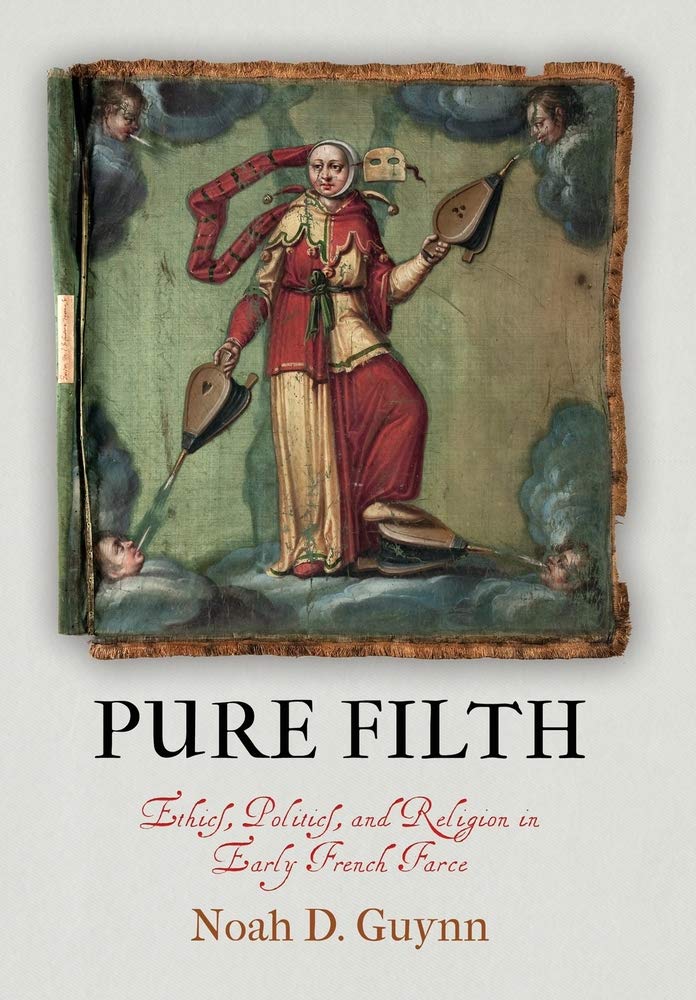

In a review of The Closet (Le Placard) in The New Republic, Stanley Kaufman writes, “Strange how the two words ‘French’ and ‘farce’ go together, like ‘Greek’ and ‘tragedy.’” In the same way that Quintilian asserted that satire belonged to the Romans, one could make the case that farce belongs to France. Although most people who know about French farce tend to think of Molière in the seventeenth century or maybe Georges Feydeau in the nineteenth, the genre first flourished from the mid-fifteenth to the mid-sixteenth century, the time-period covered in Noah Guynn’s brilliant study, Pure Filth.
For anyone working on farce (and popular or festive culture more generally), a useful entry point is Mikhail Bakhtin’s influential work Rabelais and His World.[1] Bakhtin presented a nostalgic utopian Marxist vision of an unofficial, carnavalesque culture that allowed the proletariat to at least temporarily suspend established hierarchies during feast times (think Mardi Gras) and thumb their noses at authority. Subsequent critics, myself included, have highlighted how anachronistic and erroneous this characterization was. One of the central points of Pure Filth is to offer a further corrective, insisting that those who have criticized Bakhtin’s naïve nostalgia have replaced it with a different form of nostalgia, one that is equally off the mark and does not account for the full richness and complexity of premodern and early modern popular culture. As Guynn puts it, “Divorced from historical context, the corpus of surviving farces has thus lent itself to a nostalgic, reactionary, and totalizing vision of the harmless and childish antics of the lower classes at play” (13).
Guynn’s book is intentionally polemical, seeking to redress supposed mischaracterizations of farce by scholars like me. To his credit, he acknowledges that there are a good number of medievalists whose understanding of farce mirrors my own. Most importantly here, my own thinking about the genre has changed after reading Pure Filth. Other important scholars, such as Sara Beam and Jelle Koopmans, have previously helped nuance and improve my own understanding of farce, as has Guynn’s previous scholarship. If Beam’s Laughing Matters: Farce and the Making of Absolutism in France(2007) is arguably the best historical study of French farce, I feel strongly that Pure Filth is the best literary study of the genre.
Guynn judiciously chooses a limited number of farces, including the genre’s masterpiece, the Farce de Maistre Pierre Pathelin, and carefully lays out an extended case for the complexity, if not outright contradiction of established norms, and rebelliousness of farce. Over the course of four chapters, Guynn covers politics and ethics, religion and theology, gender and queer theory. His overall approach is highly theoretical with a heavy dose of theorists from Derrida to Butler, peppered with Proustian sentences packed with a solid dose of jargon and neologisms.
Guynn’s ability to expose the intricacies and subtleties of a genre that, at first glance, seems anything but subtle, is noteworthy. While all of the chapters are engaging, the most innovative and compelling are two and three, which deal primarily with religious and theological issues. First, it is refreshing to see a scholar taking seriously not just Pathelin, but the sequels it inspired. While the fate of most sequels is to produce a painfully pale imitation of the original (think Godfather Part III), Guynn does an impressive job revealing hidden gems in the otherwise tedious sequels of Pathelin. As good as the chapter is, the next one is even better. Like many others, I have always divorced Andrieu de La Vigne’s Mystère de Saint Martin from the farces he produced as part of the production, seeing them as comical interludes intended to lighten the mood before returning to the seriousness of the mystery play. Guynn has changed my mind about this and helps his readers to understand the powerful theological critiques embedded in these farces, critiques that call for a reconsideration of the mystery play. Through careful readings of the plays, with a particular focus on the religious authorities and doctrinal issues such as last rites, Guynn makes a strong case that the plays actively resist religious conformity and acceptance of ecclesiastical authority. There is much more than nose thumbing going on in these plays and after reading Pure Filth, my own understanding of these farces has been altered.
The final chapter may be the biggest crowd pleaser, dealing as it does with gender and queer theory. First, it would be hard to pick a genre better able to illustrate the fluidity of gender. Farce is queer to its core, with male actors dressed as female characters who sometimes then disguise themselves as males. If theater is the realm of masks, farce’s favorite disguise is cross-dressing. Guynn does an outstanding job showing how these plays destabilize gender boundaries and question gender hierarchies. However, his argument that farce is not misogynistic is less persuasive. While queer theory and feminist theory do intersect, they are not the same thing. As Natalie Zemon Davis put it years ago in her seminal essay “Women on Top,” triumphant female characters are inherently comic because of a set of misogynistic assumptions about women.[2] One of the reasons why female characters almost always triumph in farce is that they are seen as more conniving and duplicitous than their male counterparts. While Guynn makes an elaborate case for “shadow feminism,” his argument is not convincing. Queering the masculine does not necessarily amount to affirming the feminine, as he argues. And he has to make some rather tenuous assertions that seek to rebut the ubiquitous misogyny of the genre in order to reach this assertion in the conclusion: “I see no grounds for considering these plays antifeminist, nor does the term protofeminist do justice to their daring experimentation with gendered power exchange” (225). Nothing antifeminist about farce? On the contrary, the misogyny of the genre is remarkable even when considering its historical context.
I applaud Guynn’s reminders that history is not teleological, that the inexorable march towards progress is a myth. One only needs to consider the current political situation is the US and elsewhere to recognize this. And for those of us who teach literature from previous centuries, we are all engaged in the same battle Guynn is waging: pointing out, again and again, that our students’ view that we live in a much more enlightened time is faulty. To give just one example, Guynn references a study that showed that the gender wage gap in England was nearly identical in the years 1363 and 2002 (222). As I often point out sarcastically in the classes I teach on the Middle Ages and the Renaissance, “Well, it’s nice to see how we as a society have collectively moved beyond the evils of racism, sexism, and bigotry. Nothing to see here!”
In Guynn’s conclusion, he expresses the following wish: “If there is anything I hope to have achieved in this book, it is to have shown that similar forms of ethical, political, and religious novelty abound in farce, a genre that has often been consigned to the trash bin of history but that displays an uncanny ability to challenge cherished conceptions of modernity as rupture and to make a repudiated past live again” (224). He has accomplished this goal with remarkable erudition and insight. In Pure Filth, a book that will become a standard reference for people studying farce, Guynn has brought new life and energy to these seemingly innocuous plays, showing his readers that the concerns addressed in farce are our concerns, that farceurs were engaged in a serious battle against repressive authority and hegemonic practices.
Bruce Hayes is a professor of French and chair of the Department of French, Francophone & Italian Studies at the University of Kansas. His latest book, Hostile Humor in Renaissance France (University of Delaware Press, 2020), explores the religious, polemical use of humor and satire in the decades leading up to the French Wars of Religion. In his first monograph, Rabelais’s Radical Farce: Late Medieval Comic Theater and Its Function in Rabelais (Ashgate, 2010), he showed how farce was appropriated by Rabelais and used to attack educational and religious institutions.
Pure Filth. Ethics, Politics, and Religion in Early French Farce
By Noah D. Guynn
Publisher: University of Pennsylvania Press
Hardcover / 272 pages / 2019
ISBN: 9780812251685
[1] Bakhtin, Mikhail. Rabelais and His World. 1984. Translated by Helene Iswolsky. Cambridge: MIT University Press, 1968. Reprint: Bloomington: Indiana University Press.
[2] Zemon Davis, Natalie. Society and Culture in Early Modern France. 1965. Stanford: Stanford University Press.
Published on November 10, 2020.




